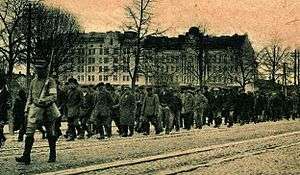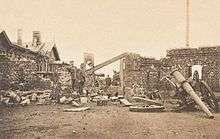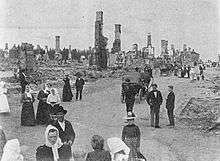Battle of Vyborg
| Battle of Vyborg | |||||||
|---|---|---|---|---|---|---|---|
| Part of the Finnish Civil War | |||||||
 Captured Reds in Vyborg. | |||||||
| |||||||
| Belligerents | |||||||
|
|
| ||||||
| Commanders and leaders | |||||||
|
Ernst Löfström K. F. Wilkman Aarne Sihvo Eduard Ausfeld |
Oskar Rantala Edvard Gylling Kullervo Manner Mikhail Svechnikov | ||||||
| Strength | |||||||
| 18,500 | 5,000 in combat units | ||||||
| Casualties and losses | |||||||
| ca. 400 killed |
ca. 500 killed in action ca. 800 executed 11,350 captured | ||||||

The Battle of Vyborg was a 1918 Finnish Civil War battle, fought 24–29 April between the Finnish Whites against the Finnish Reds in Vyborg. Together with the battles of Tampere and Helsinki, it was one of the three major urban battles of the Finnish Civil War. The battle is also remembered of its bloody aftermath, as the Whites executed up to 400 Russian civilians.
Background
At the time of the Finnish Civil War, Vyborg was the second largest city in Finland, with about 80,000 people. The surrounding Viipuri Province was the largest Finnish province with a population of 540,000. Vyborg was also the most multicultural city in Finland with a large minority of Russians and smaller minorities of Swedes, Germans, Tatars and Jews. Its location at the Karelian Isthmus near the Russian capital Saint Petersburg made the city an important center of transport and trade. During the Civil War, Vyborg was under Red control from its beginning in late January. Since 9 April, Vyborg was the capitol of Red Finland as the Red Government and the Red Guard general staff left Helsinki.[1]
The units
The White Army formed a new unit for the offensive. The 18,300-men-strong Eastern Army (Itäarmeija) was under the command of the former Savo Division leader general major Ernst Löfström. It was composed of three regiments; the Western Unit was commanded by lieutenant colonel Aarne Sihvo, the Northern by general major Karl Fredrik Wilkman and the Eastern by the German colonel Eduard Ausfeld.[1]
The defense of Vyborg was first led by the head of the Red Government Kullervo Manner. After Manner fled to the Soviet Russia on 25 April, he was followed by Edvard Gylling. The Red Guard leader was Oskar Rantala, with the Russian colonel Mikhail Svechnikov as his military advisor. On the days of the battle, there were more than 12,000 Reds and their families in Vyborg. About 10,000 were refugees who had fled from the western parts of Finland. The combat units had up to 5,000 fighters, including forces retreating from the Karelian Front and some members of the Vyborg Women's Red Guard.[1]
Encirclement of Vyborg
The offensive against Vyborg was launched 19 April when colonel Ausfeld's unit marched to south from Rautu, in order to block the Reds' connection to Russia. 23 April Ausfeld cut the St. Petersburg railroad in Raivola, 75 kilometres east of Vyborg. In the following evening, his troops took the villages of Terijoki and Kuokkala by the Bay of Finland. Terijoki Red Guard, commanded by the infamous Heikki Kaljunen, was the last Red unit to escape and cross the border. On the same day, the Northern Regiment headed towards Vyborg from Antrea, which is located 30 kilometres north of Vyborg.[1]
In the evening of 23 April, the Red general staff in Vyborg ordered all forces of the Karelian front to retreat to Vyborg. The Reds of Joutseno, Antrea and Taipalsaari first marched to Lappeenranta and were then transported to Vyborg by train on the night of 24–25 April. At the same time, most of the Red Government fled to St. Petersburg by sea. Edvard Gylling was the only Red leader to stay in Vyborg. Gylling had negotiations with the German colonel Ulrich von Coler, but von Coler did not promise to treat the Reds by the Hague Convention. The Reds then had a meeting at the Vyborg Castle, where they decided to defend the city. Red units were divided into three units; the Nortern Batallion was commanded by the worker Otto Vuoristo, Eastern by the Lappeenranta Red Guard leader Viktor Ripatti and the Western by the actor Jalmari Parikka.[1]
On 24 April a company led by von Coler took the Tali railway station 10 kilometres north of Vyborg, cutting the Vyborg–Joensuu railroad. His unit then evaded Vyborg and took the two nearest railway stations of the St. Petersburg railway. In the evening, von Coler defied his orders by attacking the city, but could not break through the Red defense on the eastern side of the Papula Bay. As the Sihvo's regiment blocked the city from the west, Vyborg was now encircled by the White Army and the only way out was by the sea.[1]
Battle in the city

On the night of 23–24 April, the underground Vyborg White Guard was activated. The Guard took the artillery fort in the Patterinmäki Hill, but in the morning they had to surrender, as the Whites could not hold the governmental buildings. The White Army made its first efforts to enter the city on 25–26 April but the Reds managed to push them back. The Whites had great losses, as they used conscripted units without former combat experience. Some of the men even had sympathies for the Reds.[1]
The Whites launched their decisive attack on 27 April at 12 PM. It was preceeded by hours of artillery fire, which destroyed the Patterinmäki Fort and the working-class neighbourhood of Kolikkoinmäki. The conscriptees were now mostly replaced by White Guards who had been fighting in the Karelian Front and White Army soldiers from the Savo Front.[1] On the night of 27–28 April, a group of Reds entered the Vyborg Prison, where leading Whites had been kept for several weeks. After hours of heavy drinking, they shot more than 30 prisoners. Among the victims were two members of the Finnish Parliament, Leander Ikonen and Matti Pietinen.[2][3]
The Whites finally took the city after heavy street fighting on the morning of 29 April. 1,000 Reds managed to break through the siege and headed west but they were soon captured. 500 of them were found shot dead.[2] Some of the Reds were also evacuated to Saint Petersburg by sea.[1]
Aftermath
As the Whites took Vyborg under their control, they conducted a large mass execution. Some 1,200 people were shot, including up to 400 Russians, who were mostly civilians. Today their execution is concidered as an ethnic cleansing. Ironically, most of the Russian victims were merchants and businessmen who were White supporters and even had greeted them as liberators. Plenty of other foreign nationalities were also executed, as the Whites mistaken them as Russians. Other nationalities included Ukrainians, Polish, Estonian, Tatars, Jews and Italians. The largest mass executions were carried out in the Annenkrone fort on the western side of the city. Youngest of the executed were only 12–13-year-old children and at least three civilian women were also shot.[1]
On the next few days after the battle, more than 10,000 Reds and their family members were captured. During the next five months, more than 800 Reds died in the Vyborg Prison Camp of executions, hunger and disease.[1]
References
- 1 2 3 4 5 6 7 8 9 10 11 "Punainen hallinto kesti Viipurissa pisimpään". Svinhufvud – Suomen itsenäisyyden tekijät ja vaiheet (in Finnish). 2016. Retrieved 11 November 2016.
- 1 2 "Valkoisten voitto varmistui lopullisesti". University of Tampere (in Finnish). 1998. Retrieved 11 November 2016.
- ↑ Roselius, Aapo (2014). The Finnish Civil War 1918: History, Memory, Legacy. Leiden: Brill. p. 108. ISBN 978-900-42436-6-8.
| Wikimedia Commons has media related to Battle of Vyborg (1918). |